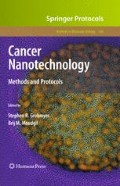Abstract
Gold nanocages are hollow nanostructures with porous walls that can be simply prepared via the galvanic replacement reaction between silver nanocubes and chloroauric acid. Their optical resonance peaks can be precisely tuned into the near-infrared region, in which the adsorption caused by blood or soft tissue is essentially negligible. Significantly, the strong absorption of gold nanocages makes them attractive as a novel class of contrast enhancement and photothermal agents for cancer detection and treatment. The well-established chemistry for gold also allows them to target specific cells by functionalizing their surface with various moieties such as antibodies, peptides, and DNAs. In this chapter, we focus on their use as a photothermal agent for the ablation of cancer cells and as a contrast agent for the in vivo noninvasive photoacoustic imaging of blood vessels and the sentinel lymph nodes in rats.
Access this chapter
Tax calculation will be finalised at checkout
Purchases are for personal use only
References
Kim, S. W., Kim, M., Lee, W. Y., and Hyeon, T. (2002) Fabrication of hollow palladium spheres and their successful application to the recyclable heterogeneous catalyst for Suzuki coupling reactions. J Am Chem Soc 124, 7642–7643.
Sun, Y. and Xia, Y. (2002) Increased sensitivity of surface Plasmon resonance of gold nanoshells compared to that of gold solid colloids in response to environmental changes. Anal Chem 74, 5297–5305.
Yavuz, M. S., Cheng, Y., Chen, J., Cobley, C. M., Zhang, Q., Rycenga, M., Xie, J., Kim, C., Song, K. H., Schwartz, A. G., Wang, L. V., and Xia, Y. (2009) Gold nanocages covered by smart polymers for controlled released with near-infrared light. Nat Mat DOI: 10. 1038/nmat2564.
Chen, J., Saeki, F., Wiley, B. J., Cang, H., Cobb, M. J., Li, Z.-Y., Au, L., Zhang, H., Kimmey, M. B., Li, X., and Xia, Y. (2005) Gold nanocages: bioconjugation and their potential use as optical imaging contrast agents. Nano Lett 5, 473–477.
Chen, J., Wiley, B. J., Li, Z.-Y., Campbell, D., Saeki, F., Cang, H., Au, L., Lee, J., Li, X., and Xia, Y. (2005) Gold nanocages: engineering their structure for biomedical applications. Adv Mater 17, 2255–2261.
Cang, H., Sun, T., Li, Z.-Y., Chen, J., Wiley, B. J., Xia, Y., and Li, X. (2005) Gold nanocages as contrast agents for spectroscopic and conventional optical coherence tomography. Opt Lett 30, 3048–3050.
Loo, C., Lin, A., Hirsch, L., Lee, M. H., Barton, J., Halas, N., West, J., and Drezek, R. (2004) Nanoshell-enabled photonics-based imaging and therapy of cancer. Technol Cancer Res Treat 3, 33–40.
Chen, J., Wang, D., Xi, J., Au, L., Siekkinen, A., Warsen, A., Li, Z.-Y., Zhang, H., Xia, Y., and Li, X. (2007) Immuno gold nanocages with tailored optical properties for targeted photothermal destruction of cancer cells. Nano Lett 7, 1318–1322.
Hirsch, L. R., Gobin, A. M., Lowery, A. R., Tam, F., Drezek, R. A., Halas, N. J., and West, J. L. (2006) Metal nanoshells. Ann Biomed Eng 34, 15–22.
Au, L., Zheng, D., Zhou, F., Li, Z.-Y., Li, X., and Xia, Y. (2008) A quantitative study on the photothermal effect of immuno gold nanocages targeted to breast cancer cells. ACS Nano 2, 1645–1652.
Sun, Y. and Xia, Y. (2002) Shape-controlled synthesis of gold and silver nanoparticles. Science 298, 2176–2179.
Sun, Y., Mayers, B., and Xia, Y. (2003) Metal nanostructures with hollow interiors. Adv Mater 15, 641–646.
Wiley, B. J., Sun, Y., Chen, J., Cang, H., Li, Z.-Y., Li, X., and Xia, Y. (2005) Shape-controlled synthesis of silver and gold nanostructures. MRS Bull 30, 356–361.
Yang, J., Lee, J. Y., and Too, H. P. (2005) Core-shell Ag–Au nanoparticles from replacement reaction in organic medium. J Phys Chem B 109, 19208–19212.
Chen, J., McLellan, J. M., Siekkinen, A., Xiong, Y., Li, Z.-Y., and Xia, Y. (2006) Facile synthesis of gold–silver nanocages with controllable pores on the surface. J Am Chem Soc 128, 14776–14777.
Yin, Y., Erdonmez, C., Aloni, S., and Alivisatos, A. P. (2006) Faceting of nanocrystals during chemical transformation: from solid silver spheres to hollow gold octahedra. J Am Chem Soc 128, 12671–12673.
Au, L., Lu, X., and Xia, Y. (2008) A comparative study of galvanic replacement reactions involving silver nanocubes and AuCl2 – or AuCl4 –. Adv Mater 20, 2517–2522.
Skrabalak, S., Chen, J., Au, L., Lu, X., Li, X., and Xia, Y. (2007) Gold nanocages for biomedical applications. Adv Mater 19, 3177–3184.
Sun, Y. and Xia, Y. (2004) Mechanistic study on the replacement reaction between silver nanostructures and chloroauric acid in aqueous medium. J Am Chem Soc 126, 3892–3901.
Yang, X., Skrabalak, S. E., Li, Z.-Y., Xia, Y., and Wang, L. V. (2007) Photoacoustic tomography of a rat cerebral cortex in vivo with gold nanocages as an optical contrast agent. Nano Lett 7, 3798–3802.
Song, K. H., Kim, C., Cobley, C. M., Xia, Y., and Wang, L. V. (2009) Near-infrared gold nanocages as a new class of tracers for photoacoustic sentinel lymph node mapping on a rat model. Nano Lett 9, 183–188.
Skrabalak, S. E., Au, L., Li, X., and Xia, Y. (2007) Facile synthesis of Ag nanocubes and Au nanocages. Nat Protoc 2, 2182–2190.
Siekkinen, A. R., McLellan, J. M., Chen, J., and Xia, Y. (2006) Rapid synthesis of small silver nanocubes by mediation polyol reduction with a trace amount of sodium sulfide or sodium hydrosulfide. Chem Phys Lett 432, 491–496.
Author information
Authors and Affiliations
Editor information
Editors and Affiliations
Rights and permissions
Copyright information
© 2010 Springer Science+Business Media, LLC
About this protocol
Cite this protocol
Au, L., Chen, J., Wang, L.V., Xia, Y. (2010). Gold Nanocages for Cancer Imaging and Therapy. In: Grobmyer, S., Moudgil, B. (eds) Cancer Nanotechnology. Methods in Molecular Biology, vol 624. Humana Press. https://doi.org/10.1007/978-1-60761-609-2_6
Download citation
DOI: https://doi.org/10.1007/978-1-60761-609-2_6
Published:
Publisher Name: Humana Press
Print ISBN: 978-1-60761-608-5
Online ISBN: 978-1-60761-609-2
eBook Packages: Springer Protocols

